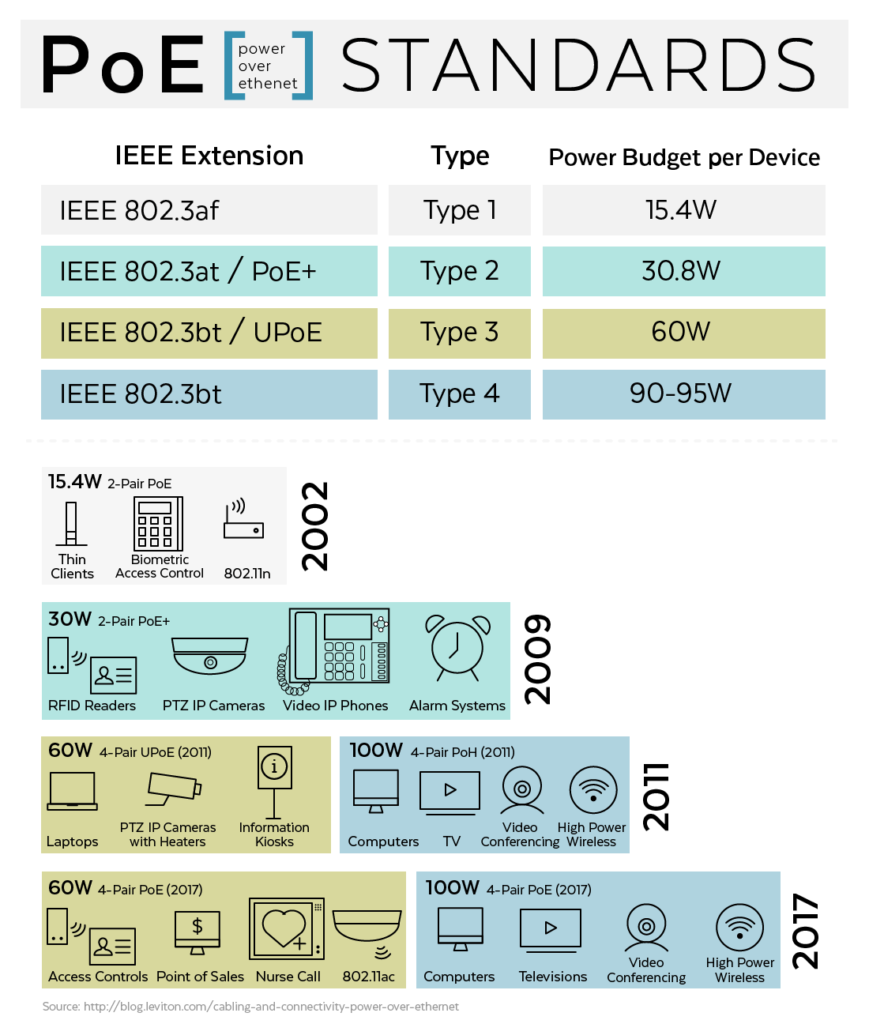Understanding PoE Standards and Wattage
Power over Ethernet (PoE) represents a significant leap in networking technology, combining data transmission and electrical power through a single cable, thereby revolutionizing the installation and operation of networked devices. This scholarly article delves into the intricacies of PoE, shedding light on its standards, wattage implications, and its pivotal role in contemporary networking realms.
The Evolutionary Trajectory of PoE Technology
PoE technology has undergone a transformative journey, evolving to meet the escalating power requirements of a broad spectrum of networked devices. This section traces the evolutionary path of PoE, highlighting its inception and the technological advancements that have expanded its application from VoIP phones to sophisticated IP cameras and beyond.
In-Depth Analysis of PoE Standards
Central to the utility and reliability of PoE are the IEEE standards, which provide a comprehensive framework for power output, voltage specifications, and device interoperability. This section offers a detailed examination of key IEEE standards including 802.3af, 802.3at, and 802.3bt, elucidating their significance and implications for network design.

IEEE 802.3af - The Pioneer
The IEEE 802.3af standard, introduced in 2003, is the first PoE standard. It supports up to 15.4 watts of DC power per port, although only about 12.95 watts are guaranteed to be available at the device due to power loss over the cable. This standard set the stage for PoE technology, providing enough power for a wide range of devices.
IEEE 802.3at - PoE Plus for Increased Demands
Recognizing the need for more power, the IEEE 802.3at standard, also known as PoE+, was established. It doubles the power per port to 30 watts, with 25.5 watts available at the device. This enhancement made it possible to power more demanding devices, such as PTZ cameras and dual-band wireless access points.
IEEE 802.3bt - Pushing the Limits Further
The IEEE 802.3bt standard, or PoE++, further extends the capabilities of PoE by offering up to 100 watts per port. This significant increase opens up new possibilities for PoE technology, allowing for the powering of devices that were previously unthinkable, such as digital signage displays and even laptops.
Understanding Wattage and Power Dynamics
The wattage capacity of PoE is a critical factor that influences the scope of devices it can support. This segment provides an analytical perspective on the power levels delineated by various PoE standards, assisting network administrators in making informed decisions regarding the integration and deployment of PoE solutions.
Voltage and Compatibility: Ensuring Synchronized Operation
Ensuring compatibility between PoE-powered devices and power sourcing equipment is vital for network integrity. This section explores the voltage ranges typical to PoE and the handshake protocol that safeguards device compatibility, highlighting the technical nuances that ensure a harmonious PoE ecosystem.
Strategizing PoE Network Configuration
Setting up a PoE network involves a series of strategic considerations, from selecting appropriate switches to understanding device power requirements. This segment provides a systematic guide to configuring a PoE network, emphasizing the importance of certification and adherence to PoE standards for optimal performance and safety.
The Multifaceted Applications of PoE Across Industries
PoE's versatility is evident in its wide-ranging applications across various sectors. This section showcases the diversity of PoE applications, illustrating how it powers devices in smart buildings, enhances security systems, and fosters innovation in various industrial domains.
Guidelines for Effective PoE Implementation
Adopting PoE technology necessitates a thorough understanding of implementation guidelines to ensure network safety and efficiency. This concluding section offers best practices for PoE deployment, covering installation techniques, cable certification, and thermal management, providing a roadmap for successful PoE integration.
Embracing the PoE Revolution
The exploration of PoE standards and wattage underscores the technology's centrality in modern networking infrastructures. By staying abreast of the latest developments and adhering to established standards, network professionals can leverage PoE to enhance operational efficiency, flexibility, and scalability, ushering in a new era of networking excellence.

